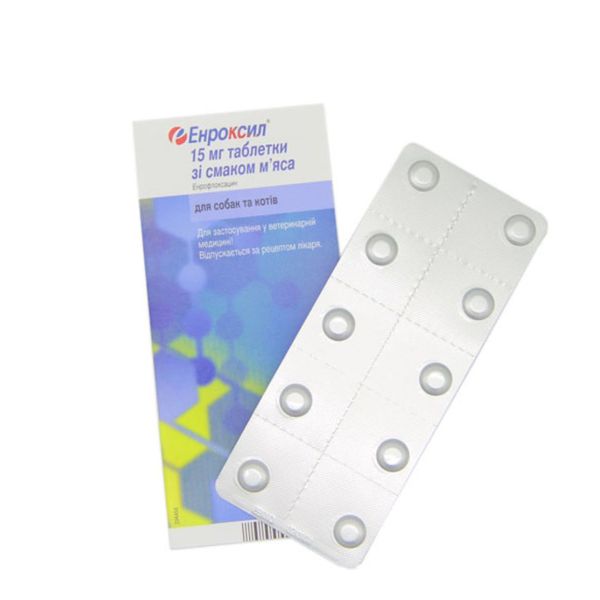|
Quantity
|
Out of stock
|
||
|
|
|||
Enroxil 15 mg, 10 tab
Description
Slightly biconvex with beveled edges, from cream to pale brownish color with possible white and dark spots.
Composition
1 tablet (55 mg) contains the active substance:
enrofloxacin - 15 mg.
Excipients: mannitol, corn starch, sodium starch glycolate, meat flavoring 10022, acrylate copolymer, sodium lauryl sulfate, dibutyl sebacate, sodium croscarmellose, colloidal silicon dioxide, talc, magnesium stearate.
Pharmacological properties
ATC vet classification code QJ01 - antibacterial veterinary drugs for systemic use. QJ01MA90 - Enrofloxacin.
Enrofloxacin belongs to the fluoroquinolone group of antibiotics. It is effective against most pathogenic microorganisms: Mycoplasma spp., E. coli, Salmonella spp., Campylobacter spp., Haemophilus spp., Pasteurella spp., Bordetella spp., Erysipelothrix rhusiopathiae, Klebsiella spp., Proteus spp., Vibrio parahaemolyticus, Staphylococcus aureus, Streptococcus spp., Clostridium perfringens, Actinobacillus spp. and enterococci. Enrofloxacin exhibits antimicrobial action by inhibiting the activity of the enzyme DNA gyrase, which is a catalyst for DNA replication in bacterial cells. Inhibition of DNA gyrase activity leads to functional disorders, blocking of biosynthesis in the cell and death of the pathogenic microorganism. It has a bactericidal effect, especially against microorganisms resistant to beta-lactam antibiotics, tetracyclines, aminoglycosides and macrolides.
In studies on dogs, when enrofloxacin was administered at a dose of 4.91 mg / kg of body weight, the maximum concentration in plasma of 1179.94 ± 260.83 ng / ml was achieved after 1.57 ± 0.62 hours. The half-life is 3.78 hours.
Almost 40% of enrofloxacin administered orally to dogs is converted to ciprofloxacin. The maximum concentration of ciprofloxacin in plasma reaches 491.99 ± 57.95 ng / mg. Tmax is 1.79 ± 2.6 h. The half-life is 5.10 h.
Enrofloxacin quickly enters tissues. The concentration in tissues and tissue fluids is 2-3 times higher than the concentration in the blood serum. High levels of enrofloxacin are observed in the lungs, liver, kidneys, skin, bones and lymphatic system. Enrofloxacin also enters the CSF, intraocular fluid and the fetus of pregnant animals.
Enrofloxacin is excreted from the body mainly with urine.
Application
Treatment of dogs and cats with diseases of the digestive tract, respiratory and genitourinary system, skin and ears (otitis externa), secondary wound infections caused by microorganisms sensitive to enrofloxacin.
Dosage
Orally at a dose of 5 mg of enrofloxacin per 1 kg of body weight (1 tablet per 10 kg of body weight) per day once or 2.5 mg (1/2 tablet per 10 kg of body weight) twice a day, regardless of feeding.
The duration of treatment is 5-10 days.
Contraindications
Hypersensitivity to enrofloxacin.
Do not use if resistant strains of pathogenic bacteria resistant to quinolones are detected.
Do not use in small breed dogs during the first 12 months of life and in large breed dogs - in the first 18 months of life.
It is not recommended to use in cats during the first 8 weeks of life.
Do not use in animals with signs of central nervous system diseases.
Do not use simultaneously with tetracycline drugs, macrolides, chloramphenicol, theophylline.
Do not use enrofloxacin for prophylactic purposes.
Warning
Quinolones cause joint cartilage damage caused by weight gain and other forms of arthropathy in young animals that are growing rapidly. Use with caution in dogs with severe renal and hepatic impairment.
Production form
10 tablets in a blister, 1 or 10 blisters in a cardboard box.
Storage
A dry, dark place out of reach of children at a temperature of 5 °C to 25 °C.
Shelf life - 3 years. Half of the tablet can be returned to the blister and used within 24 hours.
For use in veterinary medicine!
































